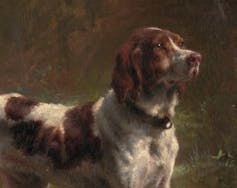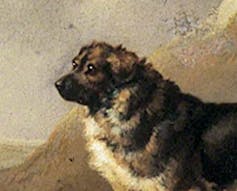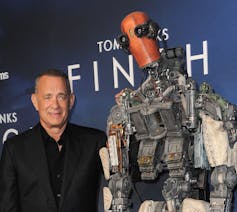, PhD Candidate of English,
Warning: The following article contains spoilers about the movie ‘Finch’
The , released in November on Apple TV+, stars Tom Hanks and a named . Critic Tomris Laffly, writing for Variety, describes it as a “.”
Hanks plays the titular Finch, a survivor in a world with a failing ozone layer. Expecting he will soon , Finch builds Jeff, a hyper-intelligent robot voiced by Caleb Landry Jones, to care for his dog, Goodyear.
Finch, like other , explores the human-dog relationship in part to define what it means to be human.
Something revealed ‘between beings’
Over the course of my research on post-apocalyptic fiction — a sub-genre of science fiction that imagines — I have been struck by how often dogs accompany the protagonists of such stories.
Fiction like (1954) and (1969), along with their respective , are some relevant examples, as is the film (1981) or the “ series.
of post-apocalyptic fiction suggest that one of the genre’s central preoccupations is the defining of humanity in relation to nature and to our place in the universe.
Similarly, literature scholar Joan Gordon, who has , argues that the speculative capability of science fiction is well suited to explore the human-dog relationship as “.”
Dogs help make a home
Finch opens with Hanks’ character picking through an abandoned supermarket looking for food, and he just narrowly makes it home before being caught in a terrible storm. “Home” is an underground laboratory, but after descending the cold metallic staircase, Finch finds a warm welcome: a mat that reads “home sweet home” and a friendly dog who perks up at his master’s return.
Just as pets in our own time , Goodyear is able to relieve Finch of the mental distress brought on by apocalyptic .
As argued by the distinguished historian of utopia, , humanity’s fear of is partially inspired by our fear of the dangers lurking beyond the bounds of our societies.
While dogs are not biologically human, Finch suggests they nonetheless assist in differentiating the safe human home from the dangerous outside world.
Dogs as companions
Goodyear functions much like the dog in , one of the by the 19th-century English Romantic novelist Mary Shelley. Shelley’s protagonist, Lionel Verney, ends the novel as a lonely survivor of a global cataclysm — in his case, a plague. Looking for companionship, Verney attempts to find sympathy among animals, but when a family of goats refuses to return his friendliness, he concedes that he “.”

But like Finch, Verney finds a companion in a dog: “[He] has never neglected to watch by and attend on me, shewing boisterous gratitude whenever I caressed or talked to him.”
While the dog appears only briefly in Shelley’s novel, humanities scholar that its appearance introduces “a perverse kind of optimism in this rigorously pessimistic novel,” for “in the novel’s final moment, at least there is the possibility of more than one living, humanized creature surviving the future.”
In both Finch and The Last Man, a line is drawn between the distinctly human realm and the realm of nature. And in both, dogs are on the side of humans.
Emotion and character
As in other post-apocalyptic stories, Finch considers the nature of human character by exploring the emotional relationship between humans and dogs. Audience members are invited to reflect upon their own emotional response.
For critic Bilge Ebiri, writing for , Hanks‚Äô pilipili¬˛ª≠ful portrayal of ‚Äúan ordinary man for extraordinary times‚Äù makes the ‚Äútear-jerking‚Äù Finch particularly effective. Hanks is able to play ‚Äúa deeply human, relatable hero, suggesting that one needs not stoicism or expertise or muscles to succeed against insurmountable odds, but rather decency and vulnerability.‚Äù
While Finch shows the positive side of human character, many dystopian works encourage their audience to reflect on their own emotions by depicting human beings acting inhumanely toward dogs.

Contemporary science fiction author Paolo Bacigalupi, for instance, depicts curious yet callous bio-engineered soldiers abusing a dog in the short story “.”
Similarly, Shelley’s contemporary Lord Byron took up this theme in his post-apocalyptic poem “.” Here, the mistreatment of a faithful dog serves to demonstrate the breakdown of human society.
Byron and Bacigalupi, as well as πÛæ±≤‘≥¶≥Û‚Äôs , all encourage their audiences to reflect on their empathetic reactions to human-dog relationships.
Trust and becoming human
The robot Jeff’s role in Finch is to gradually learn what it means to be human. The robot begins as a typically mechanical being but takes on more and more distinctly human traits as the film goes on. The final hurdle for Jeff to surpass is the gaining of Goodyear’s trust.

Early in the film, Jeff tells Finch, “I don’t think it likes me.” Finch responds: “Well he doesn’t trust you.” During a game of fetch, Jeff throws the tennis ball but Goodyear keeps returning it to Finch. Jeff once again expresses disappointment, but Finch assures him that Goodyear will come around. “Trust me,” Finch says.
As the film nears its end, we find Jeff mourning the death of Finch. Who should arrive just in time, wagging his tail and with a tennis ball in his mouth, but Goodyear looking for a game of fetch. Jeff raises his arms in excited triumph as Jeff runs to retrieve the ball.
The film’s final message, then, is captured in a passage from W. Bruce Cameron’s book (also ) about a dog, reincarnated, who returns to find his master: “.”![]()
This article is republished from under a Creative Commons license. Read the .

